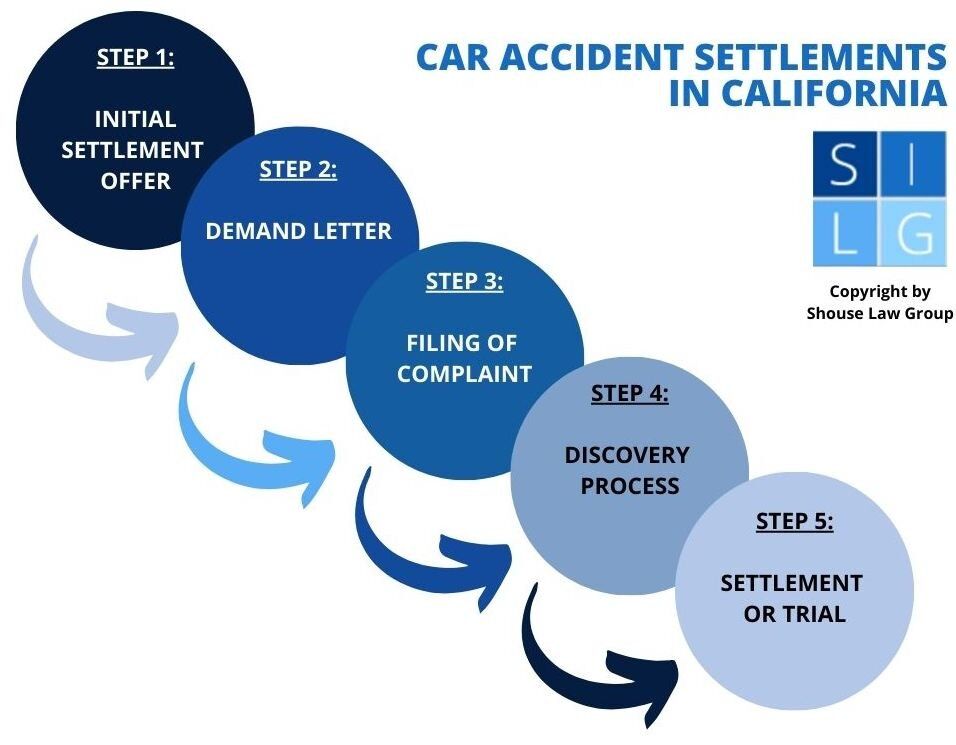

Auto accidents generally take anywhere from 6 months to 3 years to settle in California. Car accidents generally settle faster than other kinds of personal injury claims. This is because car accidents tend to cause less severe injuries than certain other types of cases, like medical malpractice.
Also, car accidents happen all the time. The commonplace nature of the claim can make for a shorter timeline because it is a smoother process.
One variable that can prolong the process is the fact that insurance defense firms charge by the hour, and insurance adjusters get paid a flat salary. Therefore, they are in no rush to pay you what you deserve.
Auto accident lawyers are well-situated to stand up to aggressive and stalling car insurance companies so you get the maximum value of your case as quickly as possible. If your case does settle and you sign a release, the insurer will typically pay you within 30 days.
The following flowchart shows the progression of car accident lawsuits in California.

The two most important factors that can change the timeline for settling a car accident case in California are:
While your willingness to compromise will speed up the settlement timeline, you may not receive all of the compensation that you deserve, particularly for pain and suffering. Many victims get scared by
This creates financial pressure to reach a settlement quickly. Unfortunately, many insurance companies try to delay the case in order to build that financial pressure to settle, and they make unreasonably low settlement offers to capitalize on your eagerness to end the case.
If both sides agree on
the timeline to settle your California car accident case will likely be much shorter.
If it is unclear who caused the accident, a settlement will likely take longer. This is because, under the rules of comparative fault, victims who were partially responsible for the accident will see their compensation reduced by the percentage of their blame.
Defendants and their insurers will look hard for any evidence that you played a role in causing the crash. They will argue that it means you deserve a lower settlement offer. 1
Until evidence is uncovered that shows who was really responsible, it can be difficult to settle the case and may prolong the settlement timeline.
Serious injuries often mean that you have not reached MMI (maximum medical improvement) before the 2-year statute of limitations has approached in California. This can push back the best moment to file the lawsuit and add time to the settlement timeframe.
Additionally, in filing your lawsuit, you will have to demand compensation for future medical expenses that are, as yet, still uncertain. Defendants fixate on that uncertainty. This factual dispute can create a substantial gap between
Severe injuries – especially those involving permanent disabilities – also mean high medical expenses. Defendants are far more likely to aggressively negotiate and challenge substantial settlement amounts than they are for smaller amounts.
In the weeks after a car accident, an insurance adjuster from the at-fault party will approach you and make an initial settlement offer. This offer usually only covers your costs for the medical attention you have already gotten for your accident injuries.
The offer may seem enticing to you if you are already concerned about being able to pay for these medical bills. However, accepting the initial settlement offer will end the case because you will have to sign a release form to receive the payout in the settlement agreement.
If you reject the initial settlement offer, the next step is to send a demand letter to the at-fault driver and their insurer. The letter states:
The insurer will typically respond within six weeks. In some cases, this will lead to a fair settlement offer. In others, the deadline will pass.
Your car accident lawyer will then file the complaint in the California Superior Court with jurisdiction over your case. This starts the lawsuit, and the complaint is served on the defendant.
This is the point in the settlement timeline where the studies show that it takes around 2 years for the case to go to trial or reach a disposition.
The defendant will then file an answer to the complaint in which they admit or deny the allegations.
The case then moves into the discovery process, which looks to uncover evidence of the remaining allegations in dispute. Common sources of this evidence in a car accident claim include:
As evidence is discovered, it will begin to become clear how much compensation you deserve. This will spur settlement negotiations.
The California Superior Court will also set a trial date. It may also set a date for a settlement conference and may even schedule mediation to get the parties to settle without a trial. (In some cases, the parties submit to arbitration.) Mediation can take several days or even weeks. 3
Only if no settlement is reached before the trial date will the case go to trial. Trials can take a few hours or several days, or longer.
For more in-depth information and historical analysis, refer to these scholarly articles: